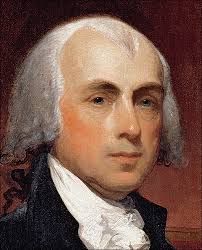FEBRUARY 8 — ELECTIONS: Madison destroys Pinckney in 1808; INVENTION/PATENTS: 1883 Louis Waterman begins experiment in making fountain pen, 1898 John Sherman (envelope and gumming macine), 1802 Simon Willard patents banjo clock; 1986 Spud Webb wins Slam Dunk Contest in NBA All-Star Game
FEBRUARY 8
1809 – Madison destroys Pinckney in the Election of 1808.
Two-term president Thomas Long Tom Jefferson was done with this office. He had no desire to seek a third term, and considering his unpopularity after the Embargo Act, halting trade to England and France and almost crippling the US, retirement seemed an easy decision for him.
His little buddy, 5’4” James Madison, barely a hundred pounds dripping wet, would take his place. Madison! From Virginia, drafter of the Bill of rights and Constitution would continue the Jeffersonian Virginia Dynasty. Current Vice President George Clinton, was before the days of Parliament Funkadelic, started out as a lieutenant in the French and Indian Wars, and then became governor of New York in 1777.
When the Revolution began, he enlisted and served though still governor. Afterwards, he wasn’t just a Democratic-Republican; he was a staunch Antifederalist that believed strongly in the Bill of Rights. Clinton came in third place during the very first election: right behind John Adams and George Washington, the returned to governor, being the longest running governor American history up until Terry Brandt tad of Iowa broke his record.
After Jefferson dropped current VP Aaron Burr, he chose Clinton to take his place for the 1804 election. Now, Clinton would become only the second vice president to serve for two different presidents besides John Calhoun. Meanwhile, the Federalist Party had chocked in the last two elections, with Jefferson winning them both for the Democratic-Republicans.
But the unpopularity of the Embargo Act brought a surge to the party, as newspapers mocked the small framed Madison for supporting a bill that would hurt the nation. The Terbium Quid’s had branched out of the Democratic – Republican Party, favoring James Monroe over Madison. Then came Charles Chatsworth Pinckney.
Also a veteran of the Revolution General Pinckney represented South Carolina in the House. After being a delegate during the XYZ affair where France used bribery as a means of talking to American delegates, Pinckney leaned towards the Federalist Party. He had already lost in the previous presidential election to Jefferson, but now the tide was turning for the Federalists. And just like that, ding ding, it was on. Madison and Clinton V Pinckney. The result wasn’t even close for the Federalists. Turned out the Electoral College wasn’t either.
On December 8, 1808, the Electors cast their ballots, and the final tally would come in on this day in 1809: Madison 122, Pinckney 47.
The Virginia Dynasty would live on.
1887 – The Dawes Severalty Act is signed by President Cleveland.
This document provided the distribution of Indian reservation land among individual tribsesmen, and was intended to encourage the native Americans to blednd in with Angle American culture. It had good intentions, kinda, but didn’t work out for the Natives at all. It was proposed by Senator Henry Dawes of Massachussets, and under his Act gave the president theauthority to divide Indian reservations into individual owned plots. Heads of households would receive 160 acres, unmarried men were given 80 and boys received 40. WomeThe bill would stall in congress until a provision was included that allowed the Anglo-Americans to split up whatever the Indians didn’t take. As a result, the Native Indians would lost about %60 of their land . With this act, Indian life fell apart as they were forced to learn how to live in a different agricultural system. Others got conned out of their properties, and disease and poverty became the norm. The Act remained in effect for over 40 years, and was replaced by the Wheeler-Howard Act which attempted to reinvigorate the centrality of tribal control and cultural autonomy on the reservations. But the damage had already been done.
In golf news…

1994 – Jack Nicholson explodes in a case of classic L.A. road rage.
Put down the 2 iron, McMurphy, nice and easy.
On February 8, 1994, Robert Blank, according to Jack, cut him off near the corner of Moorpark Way and Riverside Dr. At the next red light, Jack got out of the car and started hammering away on Blank’s Benz. On the windshield, and on the roof of the car.
Jack apparently started getting into golf after the filming of 1990’s The Two Jakes. On the course he used his 3 and 5 iron, but not his 2. Not till that day at least. Panic not people, It’s OK, Blank’s Mercedes is doing fine these days from what I hear. How about a little Anger Management Jack? I know you were hoping the Lakers were going to win another title this year, but c’mon! Calm down.
1883 – Louis Waterman begins experiment to invent the fountain pen. That’s right, world. You no longer have to dip that pesky feather into a jar of ink. Yet another reason planet Earth just needs Americans. Lewis Edson Waterman founded his company in New York in 1883 with the invention of a new feeder. He used the capillarity principle which allowed air to induce a steady and even flow of ink.
He worked on his invention for ten years before placing it on the market.[1]Waterman got a patent for his new fountain pens in 1884. 1898 John Arnes Sherman of Massachusetts 1st envelope folding and gumming machine. Also in Massachusetts 1802 Simon Willard patented the banjo clock.
1986 – Spud Webb defies that size matters. 5’7”
Anthonny Jerome Webb from Dallas Texas found a way to get into the NBA as an Atlanta Hawk. Also played for the Sacramento Kings, and in 1986 during a slam dunk contest at the NBA All-Star Game Weekend, Spud Webb, the shortest player to ever compete in this event, beat out people such as 6’8” Dominique Wilkins who was the slam dunk champ in 1985. Man’s game.

